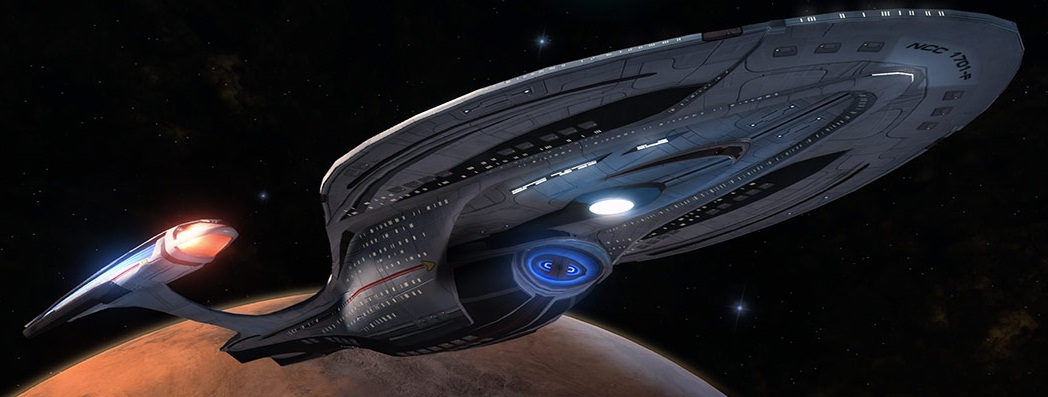Difference between revisions of "Odyssey class"
(Class and history approved for fleet canon by Pegasus Fleet admiralty.) |
(No difference)
|
Revision as of 14:29, 6 June 2020

| |
| Odyssey-class | |
| Class Information | |
| Class: | Odyssey-class |
| Date Introduced: | 2381 |
| Expected Design Duration: | 100 years |
| Time Between Minor Refit: | 5 years |
| Time Between Major Refit: | 20 years |
| Time Between Resupply: | 3-5 years |
| Dimensions | |
| Length: | 1061.1 m |
| Width: | 371.9 m |
| Height: | 147.9 m |
| Decks: | 37 decks |
| Personnel | |
| Total Crew: | 2,502 persons |
| Officers: | 417 persons |
| Enlisted: | 2,085 persons |
| Maximum (Evacuation) Capacity: | 10,608 persons |
| Propulsion | |
| Propulsion Systems: | *RCS Thrusters
|
| “Efficient” Cruising Velocity: | Warp 8 |
| Maximum “Sustainable” Velocity: | Warp 9.6 |
| Emergency Velocity: | Warp 9.99 (for 12 hours) |
| Slipstream Capable: | Yes |
| Armaments | |
| Energy Weapons: |
|
| Launchers: |
|
| Payload Types: |
|
| Shielding Systems: |
|
| Defensive Systems: |
|
| Auxiliary Craft | |
| Facilities: |
|
| Support Craft: |
|
| Other | |
| Additional Features: | |
| [ Source ] | |
The Odyssey-class starship was a Starfleet vessel first introduced in the early 2380s. It was one of the largest and most powerful Federation starship classes of its time, a true successor to the earlier Galaxy-class.
History
Development of the Odyssey-class began in the early 2370s. Even as the Sovereign-class was entering service, the Starfleet Corps of Engineers looked ahead to its next groundbreaking achievement. It was felt by some that the Sovereign had been pressed into service too soon, largely in an effort to meet the Borg threat, and that this had significantly altered the trajectory of the class itself. The plan moving forward was to design a vessel that would succeed (and ultimately surpass) both the Galaxy-class and the Sovereign-class by building upon the lessons learned from each.
No one could have imagined such a design would need to have been implemented so quickly, especially with the Galaxy- and Sovereign-classes still actively serving frontline duties. Yet, circumstances changed and Starfleet’s experiences with the Dominion War pressured engineers to once again push ahead earlier than they had planned.
The keel for the USS Odyssey was laid down in 2376 at the San Francisco Fleet Yards. Work began on a second vessel, the USS Verity, soon afterward at the Utopia Planetia Fleet Yards. Conflicts between the Odyssey, Ascension, and Excalibur projects, however, led to tension among the respective design teams and a stiff competition for resources. Ultimately, the Odyssey-class was deemed a higher priority and the necessary resources were allocated accordingly.
Despite these protests and setbacks, both the Odyssey and the Verity were launched in 2381, five years after construction had begun. They quickly proved their worth in field trials as well as on active duty and were considered by many to be a successful demonstration of the project. Unfortunately, their size placed certain limitations on the number of vessels that could be constructed, fielded, or otherwise serviced by existing fleet yards. These included the amount of physical resources as well as the personnel available. Still, Starfleet had every intention of requisitioning the class for serial production.
That all changed with the destruction of the Utopia Planetia Fleet Yards in 2385. The Starfleet Corps of Engineers immediately put a hold on further production, first to address the more urgent need of sorting out the aftermath of the attack, and then to seek other Federation facilities with the resources and the infrastructure to support such a project. They eventually identified the San Francisco Fleet Yards, the 40 Eridani A Starfleet Construction Yards, and the Gavor Shipyards as possible candidates for when the time came to resume.
The Odyssey and Verity were the absolute pinnacle of Starfleet engineering upon their launch. However, the Corps of Engineers knew that would not always be the case. Thus, it was always their intent to further upgrade and modernize the class as new capabilities and technologies became available, allowing it to remain relevant well into the future. This enabled them to use the hold on production to refine the design and to incorporate systems that had been field tested on other starships during the interim. Most notable for the Mark II Odyssey-class was the addition of quantum slipstream drive and enhanced sensor arrays.
Deck Listing
Ships Commissioned
- USS Odyssey (NX-97000)
- USS Verity (NCC-97000)


